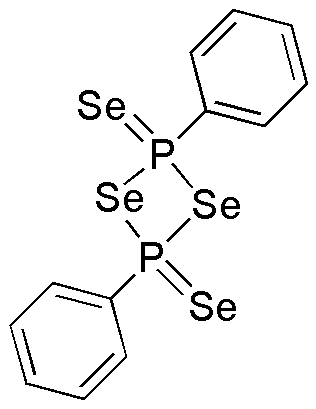Woollins' Reagent is widely utilized in research focused on:
- Synthesis of Organosilicon Compounds: It serves as a key reagent in the preparation of various organosilicon compounds, which are essential in the production of silicone materials used in electronics and automotive industries.
- Organic Synthesis: This reagent is employed in organic synthesis for the formation of carbon-selenium bonds, enabling the development of novel compounds with potential pharmaceutical applications.
- Material Science: Woollins' Reagent is used in the development of advanced materials, particularly in creating polymers with enhanced thermal and mechanical properties.
- Environmental Chemistry: It plays a role in the synthesis of selenium-containing compounds that can be utilized in environmental remediation processes, helping to detoxify pollutants.
- Research in Catalysis: The reagent is significant in catalysis research, particularly in reactions involving selenium, offering advantages in selectivity and reaction rates compared to traditional catalysts.
General Information
Properties
Safety and Regulations
Applications
Woollins' Reagent is widely utilized in research focused on:
- Synthesis of Organosilicon Compounds: It serves as a key reagent in the preparation of various organosilicon compounds, which are essential in the production of silicone materials used in electronics and automotive industries.
- Organic Synthesis: This reagent is employed in organic synthesis for the formation of carbon-selenium bonds, enabling the development of novel compounds with potential pharmaceutical applications.
- Material Science: Woollins' Reagent is used in the development of advanced materials, particularly in creating polymers with enhanced thermal and mechanical properties.
- Environmental Chemistry: It plays a role in the synthesis of selenium-containing compounds that can be utilized in environmental remediation processes, helping to detoxify pollutants.
- Research in Catalysis: The reagent is significant in catalysis research, particularly in reactions involving selenium, offering advantages in selectivity and reaction rates compared to traditional catalysts.
Documents
Safety Data Sheets (SDS)
The SDS provides comprehensive safety information on handling, storage, and disposal of the product.
Product Specification (PS)
The PS provides a comprehensive breakdown of the product’s properties, including chemical composition, physical state, purity, and storage requirements. It also details acceptable quality ranges and the product's intended applications.
Certificates of Analysis (COA)
Search for Certificates of Analysis (COA) by entering the products Lot Number. Lot and Batch Numbers can be found on a product’s label following the words ‘Lot’ or ‘Batch’.
*Catalog Number
*Lot Number
Certificates Of Origin (COO)
This COO confirms the country where the product was manufactured, and also details the materials and components used in it and whether it is derived from natural, synthetic, or other specific sources. This certificate may be required for customs, trade, and regulatory compliance.
*Catalog Number
*Lot Number
Safety Data Sheets (SDS)
The SDS provides comprehensive safety information on handling, storage, and disposal of the product.
DownloadProduct Specification (PS)
The PS provides a comprehensive breakdown of the product’s properties, including chemical composition, physical state, purity, and storage requirements. It also details acceptable quality ranges and the product's intended applications.
DownloadCertificates of Analysis (COA)
Search for Certificates of Analysis (COA) by entering the products Lot Number. Lot and Batch Numbers can be found on a product’s label following the words ‘Lot’ or ‘Batch’.
*Catalog Number
*Lot Number
Certificates Of Origin (COO)
This COO confirms the country where the product was manufactured, and also details the materials and components used in it and whether it is derived from natural, synthetic, or other specific sources. This certificate may be required for customs, trade, and regulatory compliance.


